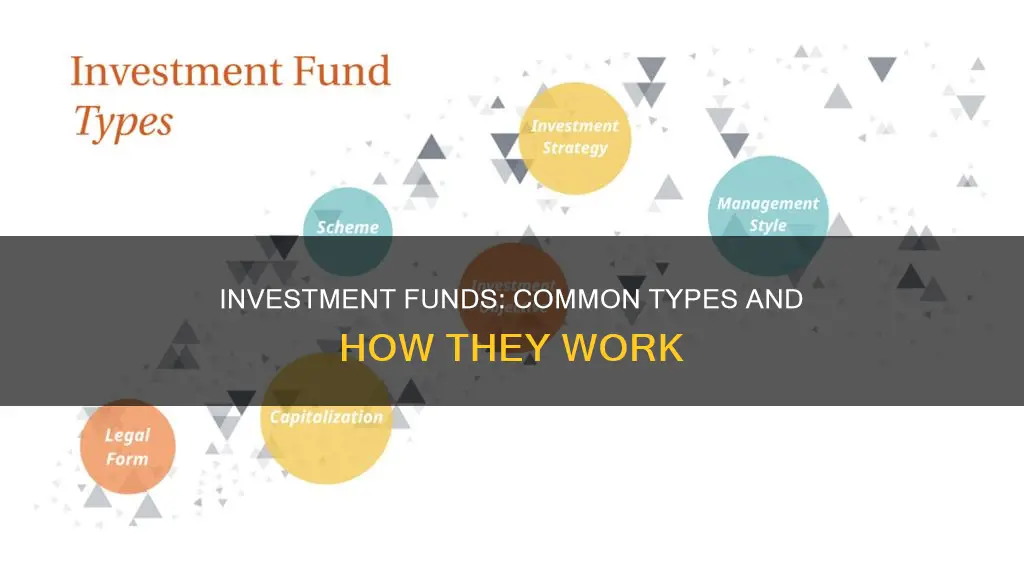
Investment funds are a way of investing money with other investors to benefit from the advantages of working as a group, such as reduced investment risk and lower transaction costs. There are various types of investment funds, including mutual funds, exchange-traded funds (ETFs), and common stock funds. Mutual funds pool money from multiple investors and invest in securities like stocks, bonds, and short-term debt. ETFs are similar to mutual funds but trade on an exchange like stocks, while common stock funds invest in the common stock of publicly traded companies, providing diversification and time savings.
| Characteristics | Values |
|---|---|
| Definition | A way of investing money alongside other investors to benefit from the advantages of working as a group |
| Investment aims | Targeting specific geographic regions or specified industry sectors |
| Advantages | Ability to hire professional investment managers, benefit from economies of scale, and increase asset diversification |
| Types | Mutual funds, exchange-traded funds (ETFs), hedge funds, private equity funds, common stock funds, index funds, etc. |
| Investment decisions | Made by a fund manager on behalf of the investors |
| Investment risk | Reduced through diversification |
| Dealing costs | Reduced due to larger investment amounts |
| Time investment | Reduced as investment research and decisions are made by fund managers |
| Owner's rights | Investors may lose certain rights, such as attending company meetings and voting |
| Investment aims and benchmarking | Each fund has defined investment goals and benchmarks to measure performance |
| Management type | Active or passive management strategies |
| Performance analysis | Analysed using statistical measures such as alpha, beta, R-squared, and standard deviation |
| Charging structure | Initial charges, annual management charges, and exit charges may apply |

Mutual funds
A mutual fund is an investment vehicle that pools money from multiple investors to purchase a diversified portfolio of stocks, bonds, or other securities. It allows individual investors to gain exposure to a professionally-managed portfolio and potentially benefit from economies of scale, while also spreading risk across multiple investments.
There are many types of mutual funds, including stock, money market, bond, and target-date funds. Stock funds, for example, can be further categorised by the size of the companies they invest in, with small, mid, or large-cap funds.
Investing Trust Funds for Children: A Secure Future
You may want to see also

Exchange-traded funds (ETFs)
ETFs combine the diversification of mutual funds with real-time pricing and can be traded live during the trading day. They offer low costs, and investors can buy a fractional share for as little as $1. ETFs are managed by experts and are a collection of hundreds or thousands of stocks or bonds in a single fund that trades on major stock exchanges like the New York Stock Exchange, Nasdaq, and Chicago Board Options Exchange.
ETFs have a few advantages over mutual funds. They are more transparent since their holdings are generally published online daily, and in the United States, they are more tax-efficient. ETFs also trade on a stock exchange, can be sold short, can be purchased using funds borrowed from a stockbroker (margin), and can be purchased and sold using limit orders, with the buyer or seller aware of the price per share in advance. Additionally, ETFs are generally cheaper to operate than mutual funds since they do not have to buy and sell securities and maintain cash reserves to accommodate shareholder purchases and redemptions.
ETFs can be structured to track anything from the price of a commodity to a large and diverse collection of securities. They can even be designed to track specific investment strategies. Various types of ETFs are available, including income generation, speculation, and price increases, and to hedge or partly offset risk in an investor's portfolio. The SPDR S&P 500 ETF (SPY), which tracks the S&P 500 Index, was the first ETF launched in 1993.
ETFs have grown in popularity, with assets more than doubling each year since 1995. In the United States, there is $5.4 trillion invested in equity ETFs and $1.4 trillion in fixed-income ETFs. As of January 2024, there were 1,988 ETFs in the United States, accounting for 16% of the industry.
Pharma Mutual Funds: Worth the Investment Risk?
You may want to see also

Money market funds
- Prime/Short-term credit MMFs: These funds invest in floating-rate debt and commercial paper of non-Treasury assets, which may be issued by corporations, U.S. government agencies, and government-sponsored enterprises (GSEs).
- Government MMFs: These funds invest at least 99.5% of their total assets in cash, government securities, and repurchase agreements that are fully collateralized by cash or government securities. Treasury Funds are a type of Government MMF that invests in standard U.S. Treasury-issued debt securities, such as Treasury bills, bonds, and notes.
- Tax-Exempt/Municipal MMFs: These funds offer earnings that are free from U.S. federal income tax and, depending on the securities they invest in, may also be exempt from state income taxes. Municipal bonds and other debt securities primarily constitute these types of money market funds.
- Standard MMFs: These funds are designed with a minimum investment horizon of three months and offer the opportunity for higher yields by holding less liquidity, longer duration, and slightly lower credit quality.
The advantages of money market funds include better returns than bank accounts, high liquidity, preservation of capital, diversification, operational efficiency, and yield. However, it is important to note that money market funds are sensitive to interest rate fluctuations and monetary policy changes. They are not suitable for long-term investment goals like retirement planning due to the lack of capital appreciation.
The Social Security Trust Fund: Where is it Invested?
You may want to see also

Bond funds
A bond fund is a mutual fund or an exchange-traded fund (ETF) that deals in debt instruments such as government and corporate bonds. The primary objective of a bond fund is to generate a monthly income for investors. Bond funds are an alternative to buying individual bonds, as they allow investors to buy shares in a fund that buys and sells many bonds.
The types of bond funds available include US government bond funds, municipal bond funds, corporate bond funds, mortgage-backed securities (MBS) funds, high-yield bond funds, emerging market bond funds, and global bond funds.
Most bond funds pay regular monthly income, although the amount may vary with market conditions. This feature can make bond funds an appropriate choice for investors who desire somewhat stable, regular income.
Investing in L Funds: A Smart Move for 35-Year-Olds?
You may want to see also

Stock funds
Investment funds are a way of pooling money from multiple investors to purchase a portfolio of various securities, such as stocks and bonds. The main benefits of investment funds are that they provide a broader selection of investment opportunities, greater management expertise, and lower investment fees than individual investors might be able to obtain on their own.
Common stock funds have traditionally been mutual funds, but they can also include exchange-traded funds (ETFs). Mutual funds are investment vehicles that pool money from many investors to build a diversified portfolio of stocks, bonds, and other securities. They are professionally managed, and the funds are diversified to spread risk and maximise returns. Mutual funds are designed for long-term investors and trade only once a day after the markets close.
ETFs are similar to mutual funds in that they pool money from many investors. However, they trade like a stock on exchanges such as the New York Stock Exchange (NYSE) or NASDAQ and can be traded at any point during the trading day. ETFs offer diversification, often at lower costs than traditional mutual funds.
There are two main types of common stock funds: broad-based funds and index funds. Broad-based funds are known for their diversification, as they invest in the common stock of companies from multiple sectors and industries. Index funds, on the other hand, invest in stocks that comprise a specific index, such as the S&P 500, Dow Jones Industrial Average (DJIA), or Nasdaq Composite. The goal of index funds is to replicate the returns of the index they track.
When investing in a common stock fund, it is important to consider the fund's investment objectives and portfolio construction, which are always listed on its website or in its prospectus. This information will convey to an investor exactly what the fund is investing in and how. Additionally, investors should look beyond the fund's name and see what it actually holds when evaluating whether the fund aligns with their investment objectives.
Mutual Funds and ETFs: A Beginner's Guide to Investing
You may want to see also
Frequently asked questions
An investment fund is a way of investing money with other investors to benefit from the advantages of working as a group, such as reducing the risks of the investment.
Advantages include the ability to hire professional investment managers, who may offer better returns and more adequate risk management, as well as benefiting from economies of scale, such as lower transaction costs.
Common investment funds include mutual funds, exchange-traded funds (ETFs), money market funds, bond funds, and stock funds.
Mutual funds are a popular choice among investors as they offer professional investment management and potential diversification. They pool money from many investors and invest in securities such as stocks, bonds, and short-term debt.
ETFs are similar to mutual funds but trade on an exchange like a stock. They are often considered a type of index fund as they track a benchmark index and aim to mirror its performance.







